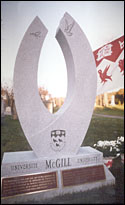A last thanks
They don't get buildings named after them, or scholarships. They don't even get a statue on the downtown campus. However, on the first Friday of every June some of the University's most important and generous donors receive the heartfelt thanks of McGill students.
 Donor monument
Donor monument |
|
On June 7, the Birks Building Chapel will provide the setting for the annual commemorative service for those who donated their bodies to McGill for the use of students enrolled in medicine, dentistry, nursing, physical and occupational therapy, and science undergraduate anatomy classes. Started more than 15 years ago by former professor of anatomy Dr. Dennis Osmond, the memorial service is intended to serve as a way for medical students to acknowledge the ultimate gift that these strangers had given them.
"By holding this service, and inviting the families, it's like closure. The service is beautiful," said anatomy professor Sandra Miller, who has been involved in the event since its inception, and has coordinated it in its entirety since 1999. She said that in some cases donor families did not have a service for their loved ones, and the McGill event fills that function. Often families don't want to come -- many were opposed to the idea of a loved one donating their body to McGill.
"Dr. Osmond didn't know how well it would be received, if at all. Would the families want to come? What would they think of it, and what would their position be with their own personal services?" explained Miller, who said that the discomfort is often relieved by the service.
It's no small event. The service requires 10 student ushers, four students to recite the donor names, 18 who read reflections on the meaning of the donor's gift to them, as well as student musicians to provide music for appropriate parts of the service. The student reflections are the largest part of the service, and they take place in French and English.
"It's a learning experience for the students, because they will have to confront families after they've just lost a patient in the operating room. There's going to be many times when they're going to have to talk to the families and say 'I'm sorry, Uncle Joe died,'" said Miller.
David Kimpel, a second-year medical student who participated last year, spoke of the service.
"It was a good reminder of the sacredness of human life. When we first approached our cadavers there was a sense of awe of what we were about to do for the first time. Throughout the year we would get used to going into the anatomy lab. You lose sense of the fact that these were people that had lives of their own. When you go to the memorial service it brings it back to its proper perspective," he said.
Reverend Gwenda Wells, director of McGill's chaplaincy service, has participated in the memorial for the past four years. She remains impressed by the amount of thought and gratitude the students put into their reflections, and into the experience of the anatomy labs.
"The reflections have a sort of intimacy about them. One reflected on the hands, while dissecting them, what the hands would have done through their lifetime," said Wells. "I really feel that McGill doctors gain something from the experience of acknowledging the specialness and the particularity of what has been given to them."
Once the service is finished, the donors are interred in Mount Royal cemetery. The cemetery donated a plot of land a few years ago, along with an impressive monument. Shaped like an unfinished oval, meant to suggest both the letter "U" for university, and the symbol for infinity, the monument is adorned with two doves. One, perched on a branch, represents students. On the opposite arm of the "U" the other dove flies toward the unfinished "open" edge of the stone, representing the spirit of the donor taking its leave. A McGill flag flies nearby. In addition, the donors' names are inscribed in gold in a large leather volume that sits in the entrance to the anatomy museum in the Strathcona Building.
The service has grown from a small ceremony with a few students to an event that now regularly attracts media coverage and is attended by the departmental deans. The importance of acknowledging the ultimate gift of the donors is fully recognized by the medical school as well.
"It's grown now so that the afternoon of the first Friday in June is built right into the medical students' agenda. In the early days it was whoever felt they could skip a lecture," said Miller.

